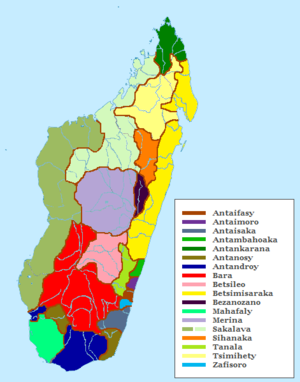
Back Malgasse (volk) Afrikaans مدجشقريين ARZ Малагасійцы Byelorussian Малгаши Bulgarian Malgaši Czech Foko German Malagassid Estonian Malgaxe (herria) Basque Malagassit Finnish Malgaches French
This article needs additional citations for verification. (September 2014) |
  Top: A Malagasy street vendor; Bottom: A traditional Malagasy Valiha orchestra | |
| Total population | |
|---|---|
| c. 26.8 million | |
| Regions with significant populations | |
| Madagascar, Comoros, Mayotte, Réunion, Mauritius, France, United Kingdom, United States, South Africa, Australia, Canada, New Zealand | |
| Languages | |
| Malagasy (L1) French (L2) | |
| Religion | |
| Christianity, Traditional Faiths, Islam | |
| Related ethnic groups | |

The Malagasy (French: Malgache or Malagasy: Gasy [1]) are a group of Austronesian-speaking ethnic groups indigenous to the island country of Madagascar, formed through generations of interaction between Austronesians originally from southern Borneo and Bantus from Southeast Africa. Traditionally, the population have been divided into sub-ethnic groups. Examples include "Highlander" (ethnically mixed ancestry but more Austronesian and slightly less Bantu) groups such as the Merina and Betsileo of the central highlands around Antananarivo, Alaotra (Ambatondrazaka) and Fianarantsoa, and the "coastal dwellers" (predominantly Bantu with less Austronesian traits sometimes like mulatto) such as the Sakalava, Bara, Vezo, Betsimisaraka, Mahafaly, etc.
The Merina are further divided into two subgroups. The “Merina A” are the Hova and Andriana, and have an average of 30–40% Bantu ancestry. The second subgroup is the “Merina B”, the Andevo, who have an average of 40–50% Bantu ancestry. The latter make up less than 2/3 of Merina society.[2] The Malagasy population was 2,242,000 in the first census in 1900. Their population had a massive growth in the next hundred years, especially under French Madagascar.[citation needed]